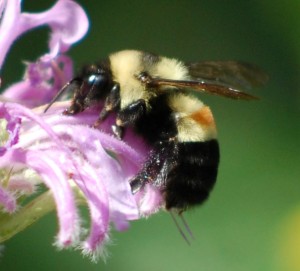Another bee species is added to the endangered species list
As of March 21st, a species known as the rusty patched bumble bee has officially been added to the endangered species list.
Obviously, bees are one of the most important species in the world, and, at this rate, the loss of more bee species could be devastating.
According to the National Resources Defense Council, “More than $15 billion a year in U.S. crops are pollinated by bees.” Adding to that, “Cross pollination helps at least 30 percent of the world’s crops and 90 percent of our wild crops to thrive.”
Without a certain number of bees, the human population could suffer tremendously.
In September of this year, the US Fish and Wildlife Service marked 7 species of yellow-faced bees endangered; the first bees to ever be put on an endangered list.
According to Joachim Hagopian, a writer for Global Research, “In the last half decade alone 30% of the national bee population has disappeared and nearly a third of all bee colonies in the U.S. have perished.”
“ . . . The rate of bee depopulation is growing each year, 42% more than the last year before . . .”
To continue, in the last twenty years alone the population of the rusty patched bumble bee has decreased a shocking 95%.
The Fish and Wildlife Service is working hard to promote and act upon conservation plans in an effort to save these bees. On their official website under the endangered species section, the organization provides methods and tips essential to help the bumble bee as well as other endangered species thrive.
The number one problem rusty patched bees face is the destruction of their home. Since they are a tunneling bee, they prefer to make nests in the ground either in vacant rodent dens or patches of tall grass. They are only attracted to undisturbed soil for all of these purposes since they need a safe place for the queen to hibernate during winter months.
Bees may not be able to find another comfortable place to settle if they are disturbed. So, if they are scared away a whole colony could die. Conservation of forests, fields and flower beds are crucial for the survival of the bumblebee.
To put it simply, the world needs bees. Without them, billions of crops would never be pollinated, food choices would be severely limited and expensive, and people may eventually have to fight over food. Saving bees could be an easy fix if more people were informed and willing to put in minimal effort.
Some ways to protect the bees are:
- Planting indigenous trees/flowers/shrubs before Spring.
- Leave sections of grass unmowed and leaf piles unraked.
- Refrain from using pesticides.
- Donate to Project Peril’s Bumble Bee Recovery Fund here: http://projectperil.greatergood.org/bumblebee/

I am in the 12th grade. I took journalism as a way to improve my writing skills and keep up with the news. In the future I want to major in engineering...









Mrs. Jennifer Brennan • Jun 13, 2018 at 1:00 pm
Such an important message in such a well research and well written article. Thank you Ms. Williams!